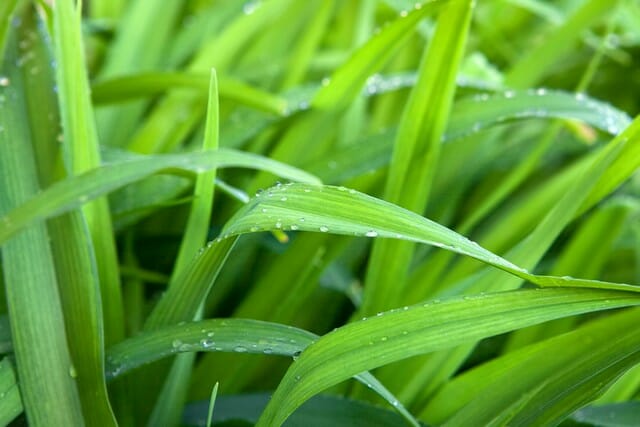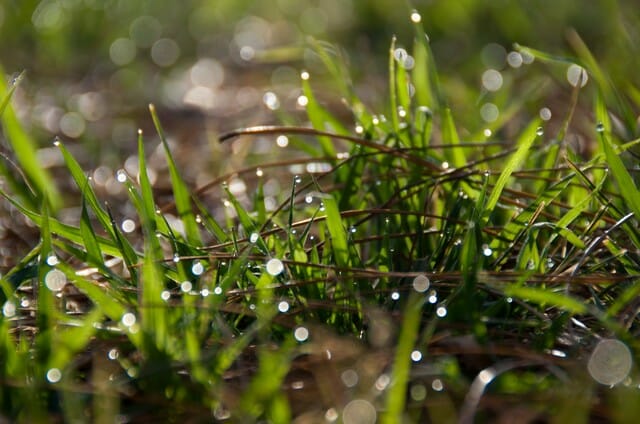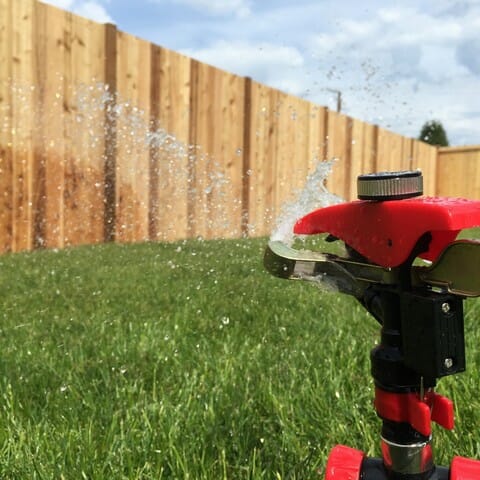Last Updated on April 18, 2022 by Grow with Bovees

You’re about to fertilize your lawn, but the forecast is promising heavy rains for the next few days.
You might be wondering, what is the best time to fertilize lawn, before or after rain has fallen?
Should you apply lawn fertilizer in the spring, summer, fall, or all through the year?
And can you put lawn fertilizers on wet grass, after heavy rainfall or other extreme weather conditions?
Is there such a thing as too much rain when planning to apply lawn fertilizer to your lawn?
If you’ve been wondering about the best time to fertilize a lawn, check out our guide.
We’ll go through everything you need to know about maintaining a healthy lawn using fertilizer, including types of fertilizer and the best time of day to use them.
What Will Be Covered?
These are some of the things we’ll cover in this article.
- Why do I need to fertilize?
- Types of lawn fertilizer.
- Is it good to have rain when you fertilize?
- Why is fertilizing your lawn after rainfall best?
- Tips for applying fertilizer after a rainfall.

Why Do I Need to Fertilize
A healthy grass lawn needs a bunch of nutrients in order to grow green and lush.
The main nutrients needed include nitrogen, phosphorus, and potassium (known as NPK on fertilizer packaging), and they are essential when it comes to proper root growth and for the development of sturdy green grass blades.
The grass gets most of these nutrients naturally from the soil it is planted in, but even if you’re blessed with nutrient-rich garden soil, it may not be enough to keep a lush lawn for the entire growing season and more nutrients would have to be supplied.
Common yard maintenance activities that keep your turf looking good can also strip it of nitrogen, which does not help the process of keeping your grass green.
Removing fallen leaves and twigs and clippings from your lawn will keep your lawn tidy, but small amounts of organic waste give nutrients back into the soil, which actually aid in the healthy growth of your lawn if left there.
The fertilization process helps replenish the nitrogen for optimal growth and achieve that thick, green mat of grass instead of a struggling turf with brown patches.
Fertilizing does not only make your lawn look lovely, but it can also help with pest and weed control. However, too much fertilizer can be bad for your lawn as well as the environment.
Types of Lawn Fertilizer
There are different types of fertilizers that come in different forms. It is a good idea to get to know these different types in order to treat your lawn properly.
Continue on to learn about the different types and forms found in stores.
Organic Fertilizers vs. Synthetic Fertilizers
Let us take you through a brief explanation of the difference between these two types of fertilizer.
Organic Fertilizer
Organic fertilizers are created from natural products, animals, or plants. They often have a more complete nutrient profile and are better for the environment.
Many gardeners prefer to use an organic fertilizer as they do not harm the environment and they will not end up burning your grass or damaging the plant roots.
Synthetic/Chemical Fertilizers
Synthetic formulas many times only include NPK and contain a limited amount of other nutrients, but they release their nutrients faster than organic fertilizers. They are however not great for the environment — in comparison to an organic fertilizer — and if not used correctly may cause water pollution.
If synthetic fertilizers are used excessively, chemical fertilizers can have a negative impact on your turf causing damage to the grass roots causing the grass to burn or in the worst case perish.
Granular vs. Liquid Fertilizer

Fertilizers also come in different forms. Continue on to learn the difference between a liquid and a granular fertilizer.
Granular fertilizer
This form of fertilizer is easy to apply well with a spreader. It’s the fertilizer we would recommend for most homeowners who aren’t experienced with using fertilizer.
You’ll need to water your lawn lightly every time after using it to help the fertilizer reach the root system of your lawn.
Liquid fertilizer
The liquid form of fertilizer needs to be applied with a hosepipe, (a hose reel cart with wheels would make things easier on a large lawn), and it’s tougher to do — well if you’re not experienced.
With liquid fertilizer, it’s easier to over apply on some areas and burn your lawn, while not spraying enough on other parts. If you do happen to burn the grass, we have a fix for burnt grass that you can follow to restore it to its former glory.
On the plus side, along with enough moisture it’s absorbed well into your soil, which is why most professional landscaping companies prefer to use liquid fertilizers.
Is It Good To Have Rain When You Fertilize?
There are many factors in the environment that may affect when you should fertilize your plants. Rain is one of them.
Ideally, you should aim to fertilize about two days after rain or watering, and when the next heavy rainfall is at least two days away.
Rain Before Fertilizing
It can be helpful to have some rain before and after fertilizing. Rain a couple of days before fertilizing keeps your yard moist and the turf healthy and receptive to the nutrients.
Rain After Fertilizing
Light watering or rain right after fertilizing, on the other hand, washes the fertilizer off the blades and onto the ground.
Heavy Rainfall & Fertilizing
Heavy rain right after fertilizing, however, may make the fertilizer run off the soil or into the lower layers, where it won’t do as much good for your roots.
It may also cause the fertilizer to run into stormwater systems which could consequently pollute the bodies of water in and around your community.
Using fertilizer on wet grass the day after heavy rain is also not ideal, because the fertilizers can stick to wet grass and damage it.
Why Is Fertilizing Your Lawn After Rainfall Best?
After rainfall, your yard is in a healthy condition to receive the fertilizer and make the most out of its minerals. The top layers might still have some water from the heavy rain, which will mix with the fertilizer and surround the roots of the plants.
On completely dry soil that hasn’t experienced rains in a while, it’s harder to distribute the fertilizer evenly. Which means that in drought conditions, you need to make sure you add sufficient water when applying fertilizer, making sure that the soil moisture is maintained during the process.

Tips for Applying Fertilizer After a Rainfall
It’s raining, and you’re wondering when to fertilize the lawn. Here are some more tips to get your lawn care right and help it grow healthy.
- Fertilizer application two days after heavy rainfall is the best way to get the most out of your investment.
- The best time to fertilize your lawn is in the afternoon or evening when the sun is not burning high in the sky anymore. This helps give the lawn a little time to absorb the nutrients.
- Apply fertilizer and give your lawn a light watering, unless you’re expecting light rain in the following hours.
- One important thing to note is that you need to keep pets and kids away from the lawn for at least 24 hours after fertilizing.
- In general, watering your lawn once a week, properly saturating the soil, instead of every day, helps promote strong root growth. If it rains a lot, lawns will not require extra water.
- Another practice for healthy lawns is keeping your grass long, between about 3 and 4.5 inches. This helps provide a greater surface for photosynthesis, which improves their overall health.
- A heavy-handed nitrogen fertilizer application will mean you need to mow more often.
- When you mow the lawn, leave the clippings on the ground as a mulch to feed the grass and reduce the evaporation of water.
When Most People Apply Fertilizer To Their Grass
Most people fertilize their lawn once or two times a year, but you can do it more often.
The right season for fertilizing lawns is when they’re growing the most. For cool-season grasses, this is in the early spring and fall. Most people apply weed and feed at this time of year.
Some people do keep fertilizing their lawns throughout the summer, at intervals of six to eight weeks, but it’s not always necessary to do it this often.
How often you need to fertilize your lawn depends on your lawn, the weather conditions, and how much rain you tend to get.
It’s important to make sure you don’t fertilize your lawn in the middle of a drought when the soil is dry and the lawn is brown. You’ll likely only end up doing damage because the soil hasn’t had enough water, and you might even burn it.
Make sure you wait for when the temperature cools down in the fall and use a slow release nitrogen fertilizer if you can. The grass will still grow during the fall, and you’ll give your lawn a stronger start the next spring.

The Bottom Line
Depending on your lawn, you can fertilize anywhere from one to about four times a year.
Don’t fertilize your zoysia grass during a heatwave or a drought, because the fertilizer can burn the blades.
It’s also best to apply fertilizer in the evening or late afternoon and water afterwards. This way, the sun won’t scorch the lawn when you’ve applied chemicals to it.
To Sum Up
The answer to the question of the best time to fertilize lawn, before or after rain, is about two days after.
It’s better to pick a time when your soil still has water but the turf is dry, when the nutrients won’t directly wash off.All clear? Just follow our tips to make the most out of your lawn care and make your turf strong and green.
